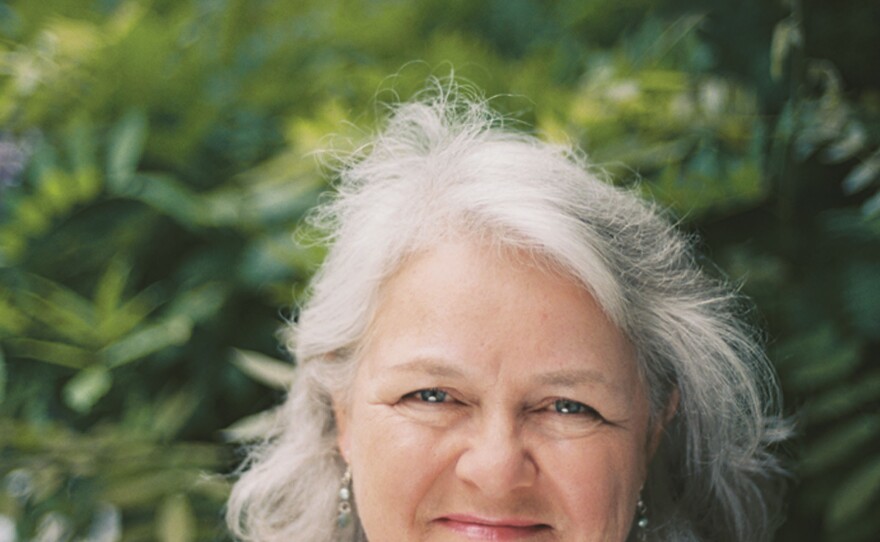Mary Norris has spent the past 20 years working as "a page OK'er" at The New Yorker, a position she says is unique to the magazine. Essentially, she's a highly specialized proofreader and copy editor on the publication's elaborate author-to-print assembly line. Alternate job descriptions include "prose goddess" and "comma queen."
Between You & Me, Norris' first book, is part memoir, part guide to the mind-bending nuances of English grammar, and part homage to The New Yorker's legendary writers and copy editors. It brims with wit, personality — and commas. Norris is a stickler who can't resist schtick. She pounces gleefully on typos everywhere, but her book is cheerier and less scolding than the "Zero Tolerance Approach to Punctuation" promulgated by Lynn Truss in Eats, Shoots & Leaves.
Norris, like Truss, addresses the proper use of commas, apostrophes, hyphens and dashes, but she has headlined the grammatical issue she cares about most: "My fondest hope is that just from looking at the title you will learn to say fearlessly 'between you and me' (not 'I') whether or not you actually buy the book and penetrate to the innards of the objective case," she writes.
Saying "between you and I" is an error that comes from trying to sound refined and from "putting another person first." Norris explains that if people weren't "so f------ polite, if they occasionally put themselves first, they would know they had it wrong. No one would begin a confidence with 'Between I and you.'"
About that profanity modifying "polite": Norris devotes a chapter to the subject. She comments amusingly that "It is as if The New Yorker had developed a raging case of Tourette's syndrome" in reaction to the days when four-letter-words were banned from its pages. Used judiciously, she argues, profanity can be powerful and fun.

While reassuring readers that "everybody makes mistakes," Norris defends the importance of standards, including the gnarly rules regarding that/which and who/whom. In response to Steven Pinker's assertion that "the who/whom distinction is on the way out," she snaps, "'Whom' may indeed be on the way out, but so is Venice, and we still like to go there."
Although readers can pick up smart usage tips, I wouldn't recommend trying to learn grammar from Norris' book. "I don't mean to make this any more confusing than it already is, but let's not pretend it's easy," she writes amid mind-numbing passages about restrictive versus nonrestrictive clauses and transitive versus intransitive verbs — which may induce unhappy flashbacks to middle school.
Fortunately, her examples and general guidelines are more engaging and helpful. She underscores her discussion of the he/she issue caused by the lack of a gender-neutral singular personal pronoun by showing how it hit home during some awkward slip-ups with her transgender sister.
Norris can't resist a homophone when demonstrating the serial comma (also known as the Oxford comma, a designation Norris abhors) — which many news organizations, including NPR, omit: "My favorite cereals are Cheerios, Raisin Bran, and Shredded Wheat." When she asked Eleanor Gould, New Yorker copy editor extraordinaire, about the plural possessive of McDonald's, Gould "very sensibly told me to leave it alone. 'You have to stop somewhere,' she said. We stopped at McDonald'ses'."
Norris' enthusiasm is infectious. She's as passionate about sharp pencils as she is about sharp writing; her tools of choice are soft graphite Palomino Blackwing 602 pencils paired with Magic Rub erasers. She travels to the Herman Melville House museum in Pittsfield, Mass., to learn who put the hyphen in Moby-Dick, and ranges even farther to visit "the Chartres of pencil-sharpener pilgrimages," the Paul A. Johnson Pencil Sharpener Museum in Logan, Ohio. She confesses a fleeting fantasy that StubHub, a ticket resale outlet in Times Square, might be her dream come true, a pencil-sharpener boutique.
Clearly, Norris has a way with words. Even her appendix of helpful books is entertaining. About Fowler's Modern English Usage she writes, "Originally compiled in 1926, H.W. Fowler's classic holds up well, not least because he's a good writer. Learn the difference between 'flotsam' and 'jetsam,' and the subtle distinction between 'foam,' 'froth,' and 'scum,'" adding pithily, "Not for use in an emergency." Between you and me, the same can be said for Norris' delightful book.
Copyright 2023 NPR. To see more, visit https://www.npr.org. 9(MDAzMjM2NDYzMDEyMzc1Njk5NjAxNzY3OQ001))





